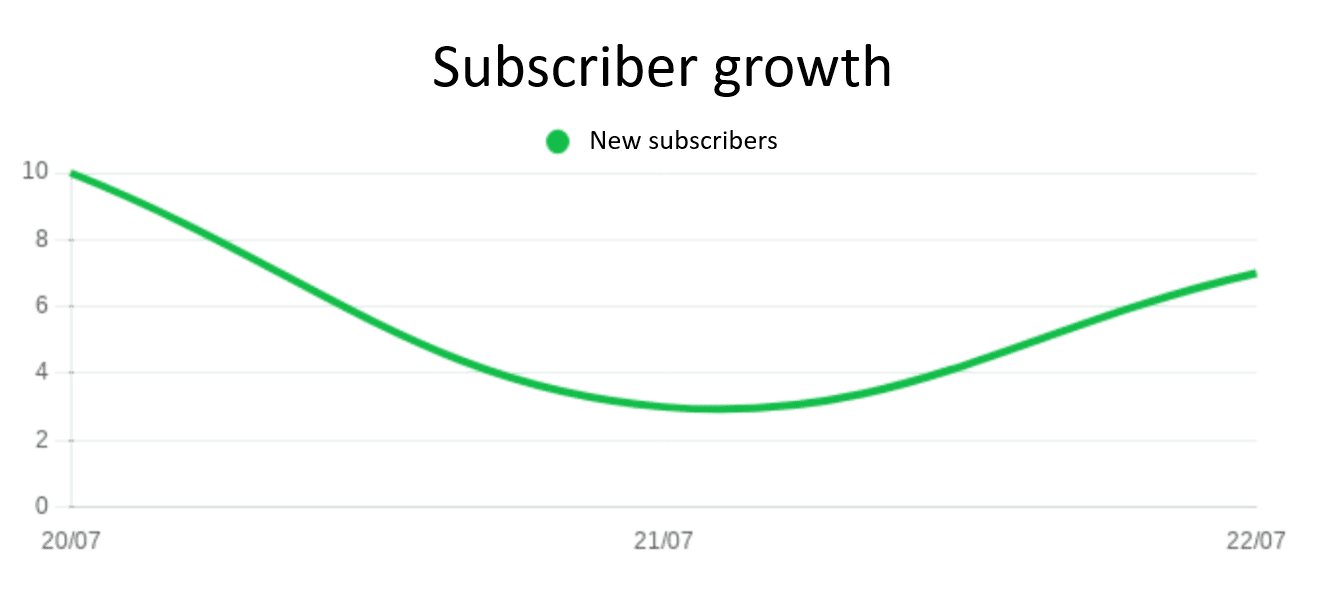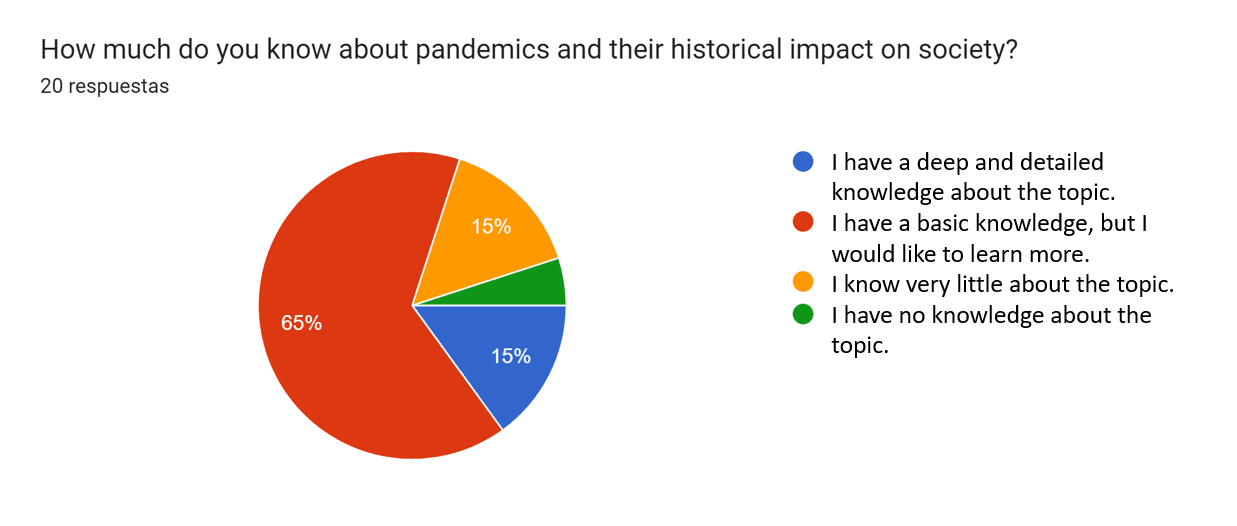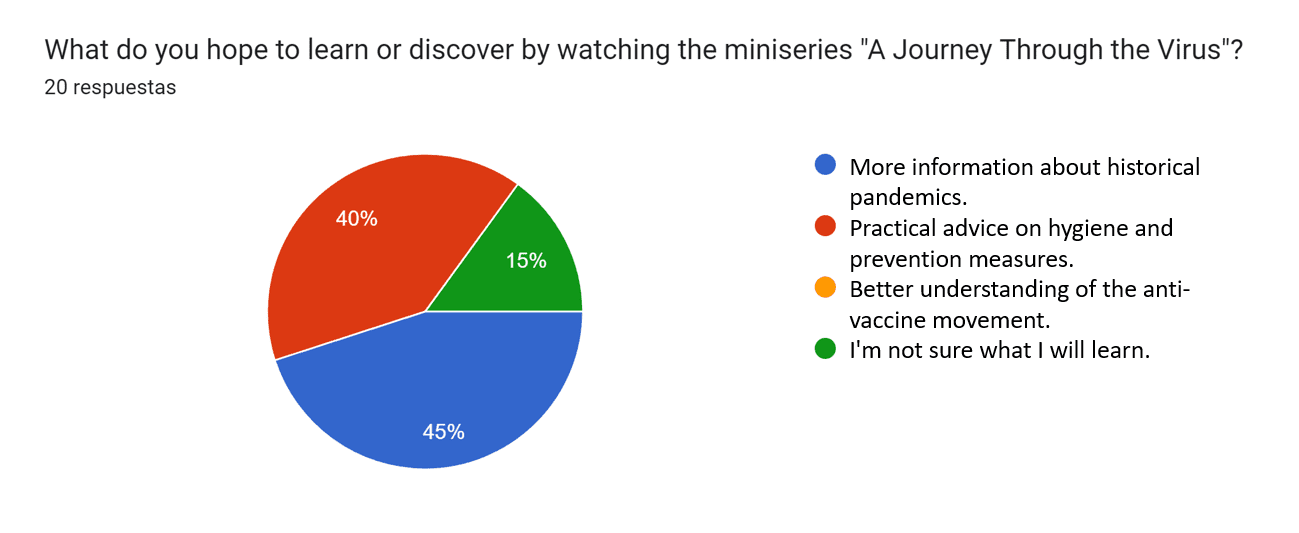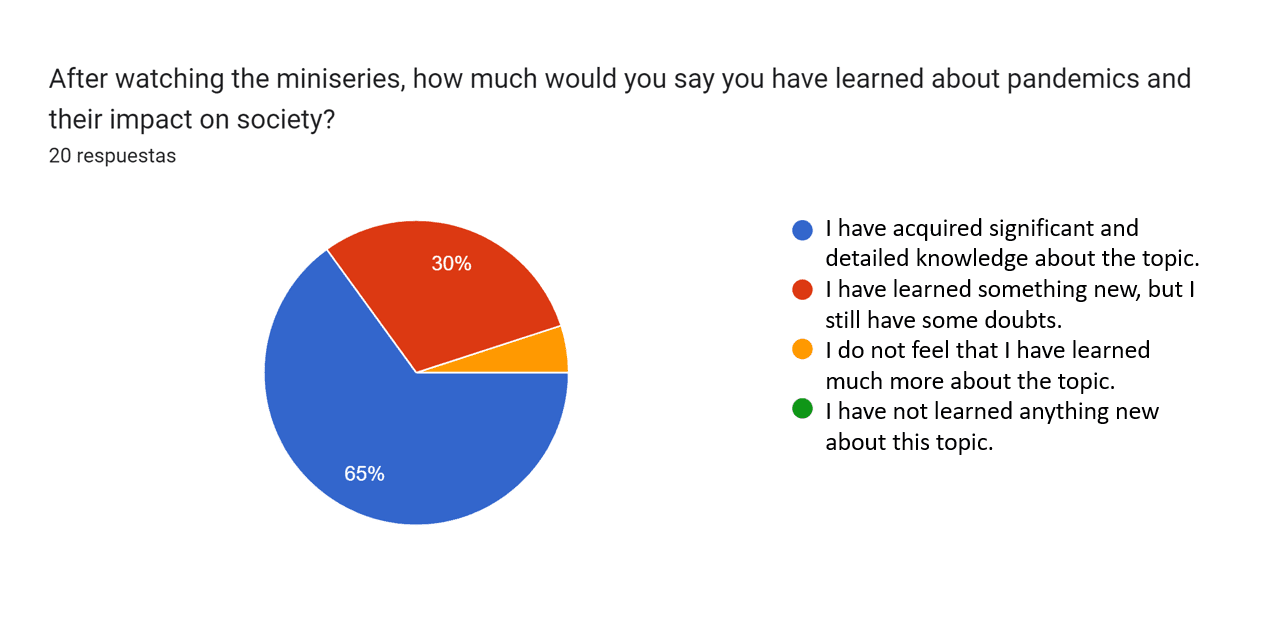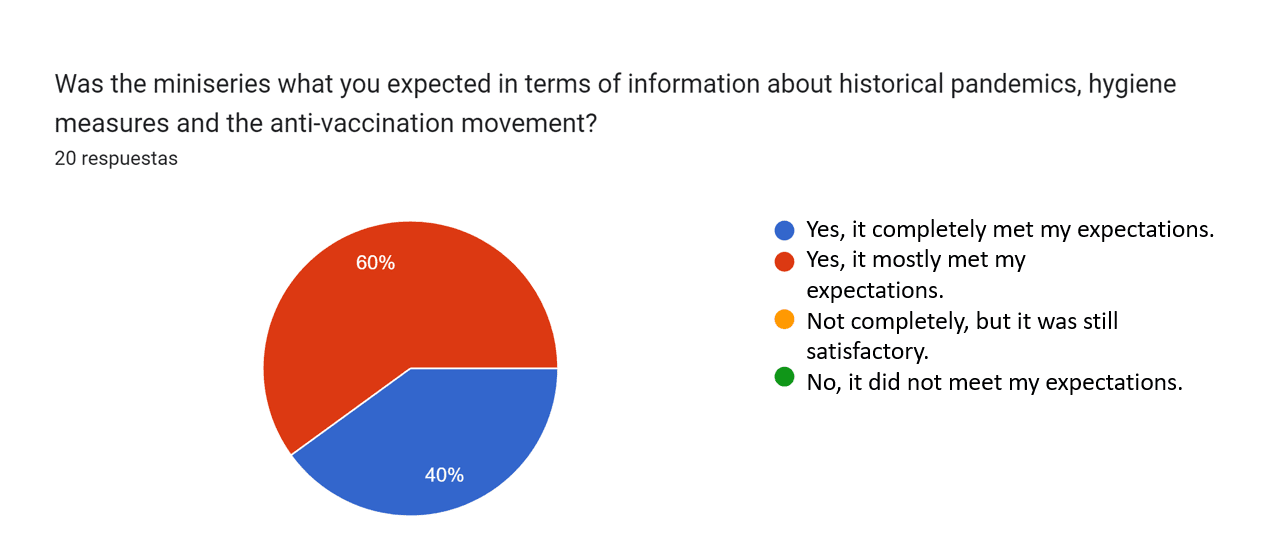Acknowledgement Note:
This project was carried out as part of the “Carreras con Impacto” program during the 14-week mentorship phase. You can find more information about the program in this entry.
Summary
This project aims to address pandemic prevention through an audiovisual miniseries published on YouTube. By combining historical elements, interviews with experts, and impactful visual content, the goal is to raise awareness about the importance of preventive measures to mitigate the effects of future pandemics. The series is targeted at a general audience, with a particular focus on young adults. Additionally, the importance of providing content in Spanish is emphasized, given the scarcity of similar educational materials in Latin America. To evaluate its effectiveness, a controlled sample of university students was used. Preliminary results suggest that while the series successfully captures attention and increases knowledge about pandemics, a more robust dissemination strategy is needed to maximize impact and foster sustainable behavioral changes.
Motivations
The rapid spread of infectious diseases and the effects of globalization in today’s world underscore the persistent threat of new pandemics and highlight the urgent need for educational initiatives that promote effective prevention and response. The general population’s lack of knowledge about the development of the most significant pandemics in human history and the preventive measures needed to avoid a similar event today are critical factors that must be addressed. This need is supported by studies such as Smith et al. (2020), which demonstrated that historical knowledge about pandemics can significantly influence society's preparedness and response to future threats.
Observing the devastating effects of recent pandemics, and driven by a firm belief that art should have a meaningful purpose, I felt compelled to create a miniseries that not only informs about historical and current pandemics but also educates and prepares the audience for future threats. The need for this content in Spanish is particularly crucial, given the lack of accessible, high-quality educational materials in Latin America. This informational gap can be a significant obstacle to effective prevention in these communities.
Thus, the project's objective was to leverage the power of visual storytelling to engage and educate the audience on the importance of pandemic prevention, providing a deep understanding of how these health crises have been managed in the past and what measures can be taken to prevent future outbreaks. This initiative not only aims to inform but also to inspire individuals to adopt responsible and well-informed behaviors, thereby contributing to global health and safety.
Methodology
The process for creating the pandemic miniseries was structured into four key stages to ensure a comprehensive and well-defined approach:
During the pre-production phase, an extensive literature review was conducted to define the content of the miniseries and develop detailed scripts for each episode. These scripts outlined the narrative, content, and visual sequence of the series. Additionally, pre-audiovisual surveys were designed and applied to a controlled sample of university students to assess their initial knowledge about pandemics and their expectations for the series. This information was crucial for adjusting the content to meet the needs and expectations of the target audience.
The topics selected for the miniseries were organized as follows:
Chapter 1: The Most Important Pandemics in Human Development.
This chapter addresses the most significant historical pandemics, such as the Plague of Justinian, the Bubonic Plague, and the Spanish Flu. It explores their causes, consequences, and how they changed the course of history.
Chapter 2: Preventive Measures
This chapter discusses the strategies and preventive measures that have been used to control and prevent the spread of pandemics, such as hygiene, vaccination, and quarantines. It also analyzes the lessons learned and how they can be applied in the future.
During production, the content was rehearsed and recorded in the preordered segments, including the episode narration and the interviewing of experts from the Autonomous University of Nuevo León, in Mexico.
In post-production, the videos were edited and processed, incorporating impactful graphics and animations to enhance the content and maintain audience attention. Tools such as Capcut were used for video editing, and Adobe Podcast was employed to improve audio quality. Supporting images were sourced from Pexels, a free image bank. Multiple versions of the material were created and reviewed to ensure the quality and accuracy of the final product. Additionally, specific segments of the chapters were created for dissemination on social media, thereby expanding the reach and interaction with the audience on platforms like TikTok and Instagram Reels.
During the dissemination and promotion stage, the full chapters were launched on a YouTube channel created exclusively for the project, and additional content was published on TikTok and Instagram Reels. The short videos were shared through my personal accounts on these platforms, which helped increase the project's reach and visibility. The impact assessment was based on the analysis of metrics such as views and interactions, complemented by post-audiovisual surveys to measure changes in audience awareness and engagement after viewing the content. The strategic scheduling of posts was key to maximizing exposure and reach. Chapter 1 was published on July 20th at 5:00 PM (Peru time), and Chapter 2 was launched on July 24th at 6:05 PM (Peru time), while the reels were released with a 2-day gap to maintain continuous interest and interaction with the audience. The times were selected to coincide with peak audience activity on digital platforms, based on studies indicating that evening and night hours are optimal for maximizing views and audience engagement.
You can access to the created content here:
- Episode 1:
- Episode 2:
The structured methodology chosen for this project was selected to ensure an orderly and rigorous development of an educational miniseries. This methodology is ideal for complex educational projects, as it provides a clear and controlled framework that facilitates the creation of coherent and high-quality content, as well as a rigorous follow-up of the audience engagement.
Results
Engagement
During the data analysis period, the YouTube channel created for content dissemination gained a total of 16 subscribers, with a notable peak in subscriber growth on July 20th, which coincided with the release of Episode 1. Additionally, there was a fluctuating growth in the following days, represented in the graph below:
Similarly, there was a steady increase in views of the generated content, accumulating a total of 1,449 views across the full episodes and YouTube shorts. This demonstrates a positive reception from the audience despite the limited time available for analysis.
Regarding the performance analysis of the full episodes, the videos received a total of 83 "likes," 11 "shares," and 4 "dislikes," indicating a good acceptance of the content compared to those who did not find it appealing. The average view percentage was 24.95%, indicating that many viewers do not watch the entire length of the long videos and lose interest as the video progresses:
As for the content in YouTube shorts format, 5 clips were created from Episode 1, with "La Plaga de Justiniano" and "La peste bubónica" standing out as the most viewed, each garnering over 600 views. On the other hand, the performance of the videos on Instagram and TikTok generated a higher number of views from the same videos, significantly improving the performance of the "Movimiento antivacunas" segment.
Video | Youtube | |||
| Views | Likes | New Subscribers | Publication Date | |
| Plaga de Justiniano (short) | 629 | 22 | 1 | 21/07/2024 |
| La peste Bubónica (short) | 616 | 29 | 6 | 22/07/2024 |
| Episodio 1: Conoce las Pandemias más devastadoras de la historia | 158 | 15 | 6 | 20/07/2024 |
| ¿Qué pasaría si una nueva pandemia infectara al planeta? (short) | 6 | 10 | 0 | 22/07/2024 |
| ¿Sabes por qué no existe una vacuna contra el VIH? (short) | 11 | 0 | 0 | 22/07/2024 |
| Episodio 2: ¿Estamos preparados para una nueva Pandemia? | 30 | 14 | 3 | 24/07/2024 |
| Movimiento antivacuna | 4 | 2 | 0 | 24/07/2024 |
Video | Tik Tok | |||
| Views | Likes | Views | Likes | |
| Plaga de Justiniano (short) | 3,548 | 19 | 337 | 34 |
| La peste Bubónica (short) | 408 | 11 | 312 | 22 |
| ¿Qué pasaría si una nueva pandemia infectara al planeta? (short) | - | - | 496 | 18 |
| ¿Sabes por qué no existe una vacuna contra el VIH? (short) | 375 | 14 | ||
| Movimiento antivacuna | 59 | 3 | 1188 | 32 |
The viewing results obtained on YouTube (summarized in the table above) suggest that short-form content may be more engaging for disseminating topics related to biosecurity, compared to long-form video content. Nevertheless, the number of new subscriptions is similar regardless of content length, indicating that content focused on these topics is of interest to the audience.
A more detailed analysis of the statistics obtained can be consulted in this document (in Spanish).
Learnings
To evaluate the impact and relevance of the miniseries "Un Viaje a través del Virus," we analyzed data from two surveys conducted before and after the series' release. The initial survey included five questions, and the follow-up survey had six. For this analysis, we selected the two most relevant questions from each survey. The detailed responses and the complete set of questions can be consulted in Spanish here.
The initial survey showed that most participants had basic knowledge about pandemics, revealing an information gap that the miniseries successfully addressed. Specifically, 65% had basic knowledge, 15% considered themselves experts, another 15% had limited knowledge, and 5% had no knowledge. This indicates that the miniseries effectively closed the information gaps.
Regarding viewer expectations, there was a strong desire to learn about the historical context and preventive practices. Forty-five percent of respondents wanted to learn more about historical pandemics, and 40% sought practical advice on hygiene and preventive measures. The anti-vaccine movement did not generate significant interest.
Initial survey: before watching the miniseries
Question 1:
Question 5::
Second survey: after watching the miniseries
The miniseries was effective in increasing knowledge about pandemics for the majority of viewers. After watching the miniseries, 65% of respondents reported having gained significant and detailed knowledge about pandemics and their impact on society. Thirty percent indicated they learned something new but still had some doubts, while only 5% felt they had not learned much more about the topic.
The miniseries was effective in increasing knowledge about pandemics for the majority of viewers. After watching the miniseries, 65% of respondents reported having gained significant and detailed knowledge about pandemics and their impact on society. Thirty percent indicated they learned something new but still had some doubts, while only 5% felt they had not learned much more about the topic.
Question 1:
Question 5:
Limitations
During the development of the project, several limitations were encountered that may have interfered with achieving the expected results:
- Restricted timeframe: Given the complex process of video production and editing, the miniseries was launched within a short period, thereby reducing the time available to analyze its performance on social media. This time constraint also prevented more extensive promotion and potentially a paid advertising campaign, which could have significantly increased the reach and visibility of the content.
- Challenges in accessing expert interviews: The absence of direct contact with Spanish-speaking biosecurity experts complicated the process of coordinating and obtaining audiovisual material. These factors limited the content and potential impact of the interviews in the series, as including expert perspectives could have enhanced the credibility and public interest.
- Language barriers: My lack of proficiency in English significantly impacted the review of literature and the search for digital information, due to the large amount of relevant reference material in this language. It is also possible that some of the central ideas might have been altered during the translation process.
Without these limitations, the project could have reached a broader audience, generated more engagement, and provided a more comprehensive view of pandemics and their impact.
Conclusions
The project has proven to be a valuable initiative for raising awareness about pandemic prevention through educational audiovisual content. Despite the encountered limitations, the results indicate that the miniseries successfully captured the audience's attention and increased their knowledge on the subject. The variability in engagement across the different types of content generated suggests that short-form content may be more effective on the selected platforms. Overall, the project succeeded in providing relevant information and promoting responsible preventive behaviors in Spanish-speaking audiences.
As for my personal experience, despite being one of the youngest participants in the Impact Careers Mentorship Program and facing additional limitations, this project has been an invaluable experience. I learned to manage time effectively and overcome obstacles in producing educational content. These skills and knowledge have not only strengthened my ability to face future challenges but also reinforced my commitment to effective communication on critical issues. I am excited to continue applying what I've learned and to keep growing in my career, knowing that every challenge faced has been an opportunity to learn and improve.
Future Directions
The project has established a solid foundation for pandemic education, but there is considerable potential for its expansion and evolution. Feedback from respondents indicated a strong interest in more detailed information on historical pandemics and preventive measures, suggesting that including additional expert interviews could significantly enrich the content and provide more up-to-date perspectives.
The analysis of engagement on platforms like YouTube showed that short-form content, such as highlighted clips, captures more public attention. Generating this type of content, combined with a more robust promotion strategy that includes advertising campaigns and collaborations with influencers and health organizations, could expand the reach of the content and foster greater global awareness. Additionally, the development of more segmented content could maintain audience attention and address the identified information gaps.
References:
- AIContentfy team. (6 de noviembre de 2023). The Power of Visual Storytelling in Boosting Content Reach. https://aicontentfy.com/en/blog/power-of-visual-storytelling-in-boosting-content-reach#:~:text=Visual%20storytelling%20is%20effective%20because%20it%20helps%20to%20capture%20the,with%20than%20text%2Dbased%20content
- Aguilera, J., González, M. B., & Perdiguero, F. J. R. (2016). Los Mensajes Híbridos en el marketing postmoderno: una propuesta de taxonomía. Revista ICONO 14. Revista científica de Comunicación y Tecnologías emergentes, 14(1), 26-57. https://www.icono14.net/ojs/index.php/icono14/article/view/890
- Arrizabalaga Valbuena, Jon. (1991). La Peste Negra de 1348: los orígenes de la construcción como enfermedad de una calamidad social. Dynamis: Acta Hispanica ad Medicinae Scientiarumque Historiam Illustrandam, 11, 73-117. https://raco.cat/index.php/Dynamis/article/view/105920
- Gibert, C. R. (2019). La peste a lo largo de la historia. Revista Enfermedades Emergentes, 18(3), 119-127. https://www.enfermedadesemergentes.com/articulos/a726/4_REVISION_ENF-EMERG003-2019_cristina-rius.pdf
- National Geographic. (s/f.). Grandes pandemias de la historia. https://historia.nationalgeographic.com.es/a/grandes-pandemias-historia_15178

